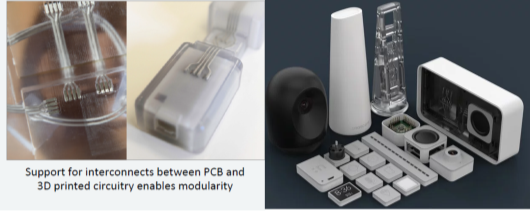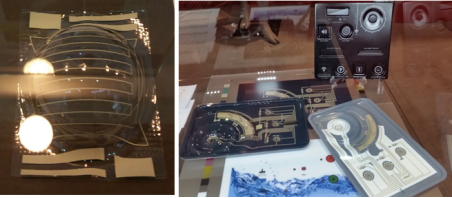Latest trends in the conductive inks business
by Dr Khasha Ghaffarzadeh, Research Director, IDTechEx
IDTechEx Research analysis showed that the conductive ink business was on the cusp of rapid and comprehensive change. Changing business dynamics has forced many suppliers to change strategy, focusing on many emerging and nascent applications in the hope that some will grow in the future to compensate for the commoditization and/or decline in core markets. In this article, we bring you an update on some of the latest trends and developments. To learn more please refer to Conductive Ink Markets 2016-2026: Forecasts, Technologies, Players.
Narrow touch screen edge electronics
The perennial trend to narrow the bezel has reduced the L/S (linewidth over spacing) of edge electrodes to 20 µm/20 µm or lower. This has meant that standard screen printing together with standard polymer thick films can no longer meet the performance requirements. In turn, this has ushered in new conductive ink technologies.
First came the photosensitive types with spherical particles. Here, a wider conductive line is first printed before being narrowed down using photo-patterning. Next came laser-cut inks with flake particles with average diameters around 1µm. Here too, a wide line is first printed before being narrowed down by laser cutting. The flake particles can give rise to higher conductivity provided good particle packing is achieved. Stable printing with constant line height is critical for precise laser cutting. The latter process is gaining traction in China where the laser cutting machines are also made at moderate prices.
The pressure to narrow the bezel will not cease. Indeed, companies have already demonstrated 15/15 and even 10/10. This means that printing processes, and not just inks, will also need to change to enable narrower lines otherwise etching based process will increase their market share.
From left to right: schematics and images showing the process and performance of laser-cut conductive inks from Toyobo, Ash Chemical and Noritake. The author took this photographs at exhibitions in Japan and Taiwan in 2016.
3D printed electronics
3D printed electronics promises to bring about a breath of fresh air to 3D printing. This is because 3D printing in plastics has to date been limited to forming ‘dumb’ mechanical objects. 3D printed electronics can dramatically change that: it can structurally integrate the circuitry into the object, thus enabling the prototyping of customized, ‘intelligent’, electronic objects.
Nascent Objects was a good example that we had highlighted previously. In fact, in our Market Intelligence Portal, we had given it a score of 9/10 for Value Proposition, Medium Term Commercial Opportunity and Competitive Landscape.
Nascent Objects developed a modular platform that enabled 3D printed electronics. Here, users could design an object in Nascent Object’s software, place the electronic modules (e.g. camera or microphone) at the desired locations, and click to 3D print. The software would plan the metallisation paths inside the object and the printing process would structurally embed the interconnects. Recognising the potential, Facebook acquired Nascent Objects in September 2016.
Whilst Nascent Objects did not utilise printed conductive inks, its approach highlighted the potential. In fact, conductive inks can be an enabling technology here. Material challenges however remain. Most importantly, the printed conductive inks need to provide higher conductivity at much lower annealing temperatures. They also require faster annealing otherwise this will become the speed-limiting step in the prototyping process.
Left: 3D printed objects with the metallized paths structurally embedded into the object. Right: Modular and interchangeable electronic components or building blocks such as cameras, clocks, etc. Source: Nascent Objects.
In-mould electronics
In-mould electronics is gaining momentum. This trend is well and alive despite the initial product re-call setback suffered in the automotive industry. Several leading suppliers around the world are now offering inks specifically formulated to be in-mould compatible.
In particular, they are changing the formulation to make the inks chemically compatible with polycarbonate substrates and to make the inks more stretchable under thermoforming conditions. The latter is achieved by changing the solvent and binder materials (e.g., polyester based formulation).
The in-mould inks currently command a substantial price premium compared to standard PTFs. The value chain is also still not yet fully formed. The moulding capability currently exists mostly at a local level only. Nonetheless, the industry is making strong process with the inks having been launched recently in a white good appliance and having been qualified for use in an automotive part.
Left: In-mould dome produced using conductive inks from Fujikura Kasei. Right: In-mould electronic parts using DuPont’s conductive inks. Source: the author tooks this photographs at C-Touch Taiwan and Printed Electronics USA (CA) in September 2016 and November 2015.
ITO replacement
There is renewed interest globally in conductive ink-based metal mesh transparent conductive films. This is because technology and application developments are making this approach more competitive. To learn more about this industry please refer to Transparent Conductive Films (TCF) 2016-2026: Forecasts, Markets, Technologies.
This is due to a variety of reasons. Capacitive touch technology is reaching the large-sized end of the market with many touch tables and touch TVs now on being prototyped or sold. This changes the technology requirements because such touch tables and TVs are likely to be heavily used in public spaces. This means that the users may tolerate seeing visible metal mesh linewidths, thereby relaxing the linewidth requirements to a range easily achievable using direct printing.
In parallel, gravure offset printing can now semi-commercially product metal mesh films with linewidths as narrow as 5µm. This makes these metal mesh solutions highly performance competitive with many approaches currently commercialized such as hybrid embossing or photo-patterning.
For the LATEST tech updates,
FOLLOW us on our Twitter
LIKE us on our FaceBook
SUBSCRIBE to us on our YouTube Channel!








